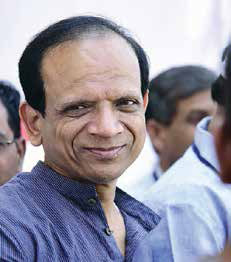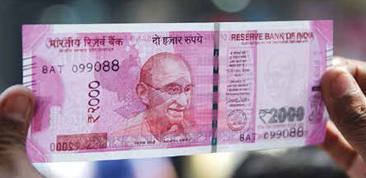
The ball has now started rolling. The process has started, now let it take its own time and complete, and then we can evaluate it. It is just the beginning of the process; it is not an event where we can quickly conclude. We should not jump to any conclusions. The demonetisation is a shock which will be absorbed and further avenues will open up. We have to be very optimistic about the future.
We don’t have any political philosophy and alignments—ours is a holistic approach and we consider that all of our 130+ crore people are ‘One Family’. We will not do or accept anything that can harm even a single person in this family. The ArthaKranti proposal is an economic solution and not a political solution. It is a well-researched scientific approach designed to transform the current grim Indian socio-economic scenario to a bright one
We met Shri Narendra Modiji, the then Gujarat CM, on 29 July 2013, at his office in Gandhinagar. What we talked with Modiji...rather we presented to him the entire ArthaKranti proposal. Demonetisation was one of the five points of the proposal.
After the presentation, Modiji had asked one question—if (only) one thing has to be removed first, what would it be? High denomination currency or flawed taxation system? We said at that time also that it is required to be done simultaneously. It can be adopted and executed in phases, but both things are necessary. Because starting point of black money generation is tax evasion, we have to remove flawed taxation system also. The vehicle that rotates this black money in the society is the high denomination currency. The cash transactions leave no footprints and are thus non-traceable, non-transparent and unaccountable. A huge amount of black money is thus generated by tax evaders in India.
In the long history of Indian trade and business, we are used to doing business by ‘Order’ and not by ‘Law’. Indian people are not against any taxes, but they are against the compliance. By nature we are against compliance. And it is true, not only for Indians, but across the world. Wherever there is a compliance requirement, there will be a resistance.
Since very early times, the Indian traders and manufacturers used to make huge donations to society—to dharmashalas and annachhatras. But when the British ruled India, they started collecting tax in the form of currency (money) and not in the form of grains or other produce. That marked beginning of the resistance. So, Indian psyche was always against such tax payment—requiring compliance. Everyone welcomes contribution and everyone is willing to contribute, that is the history of India. So, the British put in a distorted and complex form of taxation in India through the government machinery and took the money and profit to Britain. Their interest was just to collect huge revenues, because India was very resourceful then and is also now. It was a very lucrative business for them.
“Modiji was very curious about our suggestions and wanted to communicate further with us. Today also, I feel that he has taken our proposal in the right spirit and has sincerely followed it up. If you have to bring transparency in the economy, it will be through bank transactions“
After the British left India, we continued with the same tax and governing system which the British followed, without tuning it to our culture, our desires and our comfort. We just went on making it more and more complicated. The taxation system started becoming more ambiguous, unjustifiable and unexplainable. Only the law practitioners and chartered accountants took interest in it. The economists and practitioners, most of them were from the western school of thoughts and whatever they did was for the British—it was completely off-sighted.

The first point was to withdraw the present taxation system completely, because it is so distorted. It is a human tendency to avoid taxes and is found globally. That’s why we see so many people all over the world indulge in businesses in tax havens around the world—it is not India specific. The proposal makes a fundamental correction taking into account this human nature. The first point was to abolish all taxes except import duty. Main purpose of import duty is anyway not revenue generation, but balancing international trade and it can also be used as an anti-dumping duty. It can help protect domestic trade and industry. Thus, except import duty, all taxes should be abolished, in a phased manner and not in one go. That was our suggestion regarding the implementation.
The next thing was about government tax revenue. There should be a single tax, non-declaratory (requiring no compliance), and that would be a bank transaction tax. Only the receiving or credit end has to pay tax. It will be automatic and will not require any compliance. The banking system itself will deduct decided amount of tax and distribute it to different government levels-central, state and local. To do this important exercise, banks will also have a share, as a commission in the deducted amount. Today, banks’ revenue is just lending rates, in the form of interest. So our suggestion is, banks will get a commission on the velocity of circulation of money. That will be more sustainable. It will check the Non-Performing Assets (NPA) ledger also—the huge and serious problem banks are facing today is NPA. It can be addressed by giving a certain commission as a fraction of bank transactions in India. Consolidated, it will be a huge amount, which will not only produce additional revenues for the banks, but also help reduce and remove their dependence on lending interest rates.
“Demonetisation is just a correction and not a developmental step. So, it should not to be linked to the growth or development process. It may make some negative impact on growth, but only temporarily. Nothing has gone wrong now with the demonetisation—it’s a post-process analysis and the process is still ongoing.It is a process and let the process complete first”
The third point is that there will not be any tax on cash transactions. Looking at the large illiteracy, poor spread of banking network and overall non-monetised rural economy, it is not justified to put tax burden on poor people. It will not be equitable.
To move to traceable, transparent bank transactions, our suggestion is to demonetize higher denomination currency notes, say above 50 rupees. But it should not be done in one go, but in a calculated manner and in stages. In the first stage only 1000 rupee notes be withdrawn, which will be replaced with required number of 500 rupee notes. Then, after one year, 500 rupee notes will be withdrawn and 200 rupee notes are introduced as a provision and a precautionary measure. Then, observing and monitoring in an appropriate time frame, 200 and 100 rupee notes are also withdrawn from circulation.

And the last suggestion was that, a limit be set for cash transactions (say ₹2000), to enjoy legal protection. As such, cash transactions exceeding this limit will not be illegal, but, they will not have any legal protection. They will be done at own risk and in available lower denominations.
After our meeting with Modiji, as per our observation, he was very curious about our suggestions and wanted to communicate further with us. Today also, we feel that he has taken our proposal in the right spirit and has sincerely followed it up. If you have to bring transparency in the economy, it will be through bank transactions. And we believe, the Jan-Dhan Yojana and similar schemes came to his mind even before he became prime minister.
Given the huge proportion of cash transactions in India’s economy, demonetisation has been a shock. Demonetisation is just a correction and not a developmental step. So, it should not to be linked to the growth or development process. It may make some negative impact on growth, but only temporarily. Nothing has gone wrong now with the demonetisation—it’s a post-process analysis. We cannot jump to any conclusions right now and it is not the right time to do so. It is a process and let the process complete first. Once it concludes, then only we can go for any observations or inferences.
It is just a provisional measure. Taking out 85 per cent of total cash value in one go—it could shock and collapse the economy, if such a provision was not made. The government had to provide a bypass. So, we think introducing 2000 rupee currency notes is just a provisional adjustment.
Our proposal is about a systemic correction and therefore related to ‘order’. Of the ‘law and order’, the government has chosen the path of ‘law enforcement’ while we proposed setting the ‘order’ straight for things to fall in line. Government has the power while we, as an NGO, do not have that power to enforce law.
The five-point ArthaKranti Proposal has been there in the public domain for last 16 years and we have presented it to all the consecutive governments since then. It did not start as a thought process; it is an evolution of process rather. It emerged from group discussions, people coming together and thinking and discussing—what would be the best solution. We ought to provide solutions to the society. And our stand is not to put forth problems and describe issues but to provide solutions.
ArthaKranti demands limiting maximum currency value to say 50 or 100 rupees. It does not propose any limit on cash transactions. As stated in the fifth point of the ArthaKranti Proposal, cash transactions exceeding the set limit will not enjoy any legal protection. It is like you contribute to the government by way of Bank Transaction Tax and avail the relevant benefits. Look at how our society is polarised— around 70 per cent of our population lives under US $2 a day, that is, around `130 of daily consumption. This 70 per cent of our population can easily manage with 100 or even 50 rupee notes. Then, why do we need 500 and 1000 rupee notes? And 85 per cent value in total currency in 500 and 1000 rupee notes is no way justified.
It is media’s perception, we don’t buy it. You have to know that money which evades tax is black money. So, to address the problem, we have to correct the mechanism first. The black money generation and occurrence of counterfeit notes both have to be addressed. The withdrawal of high denomination currency notes can restrict movement of black money but not the generation of black money. So, now the government has to go after the sources of black money generation.
There were two parallel economies running in India—one legal and the other underground economy. But now it is going to be a single economy. Things will be completely under the control of legal economy, which will provide a big boost to the banking system and overall capital formation process. Because huge amount of cash will enter the bank, there is a certainty that interest rates will drop, making way for a cheap and easy capital to every segment of economic activity like housing, education, farmers and industry. This will in-turn increase GDP and increasing GDP will create more avenues for employment.
It will come back to India as Foreign Direct Investment (FDI). The Corruption Perception Index (CPI) for India is very high. But, thanks to population of 130+ crores, India has a huge market potential—to be a very lucrative market. If this measure of demonetisation checks corruption, the biggest hurdle in FDI coming to India will be removed. The growth rate of India is going to attract FDI, so Indian money stashed abroad will come back to India in the form of FDI and not in the form of Foreign Institutional Investors/Investments (FII). This will create a number of employment opportunities. We are certain that hereafter, most transactions in the economy will be transparent and that will check the corruption. It is a linear and progressive thing to happen.
Anil bokil